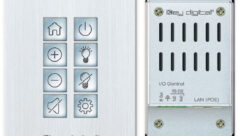Fiber is Key in Expanding Florida Corrections Implementation
Jun 14, 2006 4:30 PM
Fiber is finding increasing preference in campus-wide implementations, where its ability to carry large amounts of data securely and without danger of interruption or interference is particularly important. Campus-wide can, of course, refer to university or college settings, but as part of one large and growing application, fiber-based networks are streamlining a variety of communications tasks for one of Florida’s largest correctional complexes.
At any given time, approximately 3,600 inmates are housed in the Pinellas County Jail, Largo, Fla. The facility is currently expanding a fiber network it originally installed in 1998. Its supervisor of communications maintenance, Eliseo Santana, says, “Fiber is key to everything we’re doing that interconnects our buildings.”
The main element of the current expansion is a new 440-bed medical facility whose communications systems will run entirely on fiber. Santana says 48 new fiber lines have been installed to link the medical building with the jail’s visitor center and other facilities.
The visitor center itself is moving out of a set of triple-wide trailers and into a permanent building. In addition to the 48 new fiber connections to the medical building, nearly 250 existing multimode fibers are being relocated from the old visitor center to the new.
The jail is also adding 12 fibers connecting it to an off-campus location where police investigators and attorneys will be able to talk to jail inmates without having to travel to the jail.
In evaluating data transport needs for all this expansion, Santana says, “The distances to be covered were at the edge, where we could have gone with coaxial and saved a significant amount of money up front, because we would not have to buy fiber modems.”
However, the jail’s site presented some unusual challenges that only fiber could address. Santana terms the Largo area “the lightning capital of the world,” and adds, “Any kind of lightning strike would have wiped us out. Fiber has made us immune to this.” Maintenance needs have also been greatly reduced by the choice of fiber, he says.
The Pinellas County Jail system uses multiplexers and other components from Communications Specialties and GE Fiber. It also reflects a growing national trend of the last decade, to replace traditional face-to-face “through the glass” inmate visitation with visits via networked video. The new system offers the promise of greater security, less travel, and increased capacity.
For inmate visitation, Santana says the jail has chosen off-the-shelf 19in. TVs, which have proven to deliver excellent video quality over a longer-than-expected service life. In the new visitor center, space is at a premium, so some flat-panel displays will be combined with the TVs.
Fiber has provided high-capacity, high-reliability connection among system elements that can be as much as a mile apart on the extensive Largo jail campus. Now, though, Santana says the facility’s goal is to expand the system’s reach still further.
“We are looking into the possibility of connecting to remote sites in the northern and southern parts of the county,” he says. These sites could include such easily available public conferencing facilities as those offered by Kinko’s and other retail office service providers.
“Some of our families have to travel two or three bus routes to get here,” Santana says. Linking new remote sites into the jail’s existing fiber-enabled visitation system would have critical intangible benefits, he adds. “There is a direct correlation between the number of visits an inmate receives and their attitude and general well-being,” he says.










